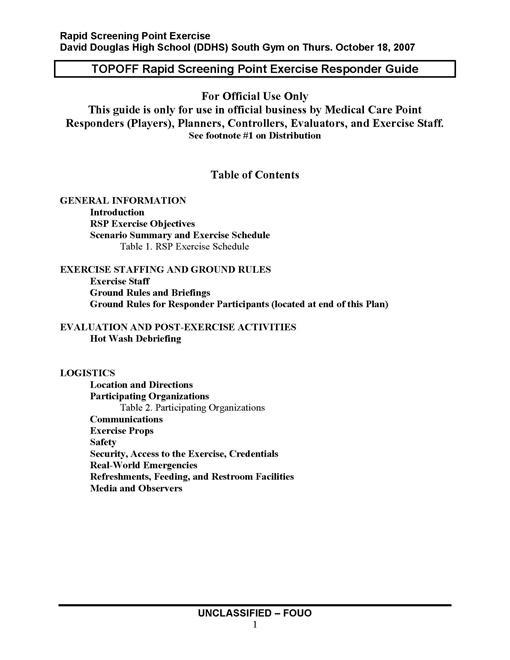TOPOFF Rapid Screening Point Exercise Responder Guide
- David Douglas High School (DDHS) South Gym
- This guide will be shared with the planning contacts of key participating organizations, the Volunteer Coordinator, Controllers and Evaluators, and TOPOFF’s Public Health Incident Commanders (the latter to ensure that preparations for this RSP are actually incorporated into their objectives, exercise play, and executed in context with other simulated RSPs). It may be shared with an organization’s participation responders at the discretion of that oraganiation’s TOPOFF planner and leadership.
- For Official Use Only
- October 18, 2007
Introduction
The Rapid Screening Point (RSP) Exercise is a component of the TOPOFF (“T4”) full-scale exercise (FSE) in the Oregon venue. An RSP is a temporary facility for high production screening of individuals with non-acute symptoms who are potentially ill or exposed to a harmful substance.”This Participant Guide contains excerpts from the Exercise Control Plan that are relevant to Responder Participants. It was drafted by James Spitzer, Emergency Preparedness Manager for the Multnomah County Health Department, in consultation with planners from other participating organizations.
RSP Exercise Objectives
Pre-RSP exercise objective. The Incident or Unified Command (IC/UC) that sets the RSP objective must design the RSPs, arrange resources to establish this and other RSPs, and create the Incident Action Plan that will govern IC/UC and RSP relationships.
RSP Exercise Objectives. The RSP Division Supervisor and leaders must:2
1. Apply Plans. Apply/adapt Public Health RSP plan and the governing IC/UC’s Incident Action Plan.
2. Apply ICS. Apply ICS criteria to assembling resources from a number of different organizations and disciplines into a cohesive, well led, and coordinated RSP Division. Especially consider unity of command, span of control, communications, and execution of the Division Assignment.
3. Production. Adjust the organization and RSP processes to gain the highest throughput consistent with the imposed protocols.
4. Relationships with Superior, Host, and Supported Organizations. Establish the situation/status sharing and supply/support process relationships with the RSPs IC/UC response organization.
Scenario Summary and Exercise ScheduleNeed for RSP. In some emergencies people may be exposed, or concerned that they may have been exposed, to a harmful substance (e.g. chemical, biological, or radiation) in an amount less than that required to produce symptoms that would prompt immediate medical care. Smaller numbers of exposed people can be accommodated by the primary care system. However, hundreds or thousands of such individuals requiring timely screening may indicate a need for RSPs. RSP staffing, layout, and flow is a variation of the Mass Prophylaxis model detailed in Tab B of the Multnomah County Health Department Emergency Response Plan. RSP objectives are to:
• Relieve pressure from a primary medical care system under severe strain from patients requiring treatment;
• Reveal who should be referred for medical treatment based on subtle symptoms and better information about actual or potential exposure to the agent;
• Relieve concerns of individuals by allowing prompt access to evaluation; and
• Gather population based information to better define the problem and better inform important response and recovery decisions, including the need to continue RSP operations.
…
10/16-17
TWO (2) DAYS BEFORE THE EXERCISE
Public Health Incident Command – in consultation with Agency Executives and political leaders
Many residents are greatly concerned about exposure to radiation, particularly those who know or fear that they or loved ones spent all or part of the time since the RDD in or near the radiation ‘plume’. Appropriate IC/UC sets objective and conducts planning to establish RSP(s) as sufficient resources and facilities become available. The David Douglas High School RSP is to be ready to receive Clients at 9 a.m. on Thurs., 10/18. A public health nurse is assigned as Division Supervisor for this RSP.
…
• Use of Force, Restraints. Actor Clients may be requested to ‘act-out’ behaviors which may include frustration and deep concern. However, they are told not to act in any way that may be perceived as a threat or that may call for physical restraint or other use of force.
Any threat of physical harm and a response of physical restraint or use of force is NOT part of the Exercise. It is a Real World Emergency and the response to it.

